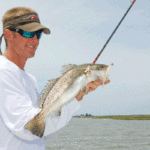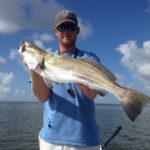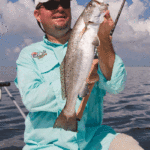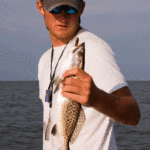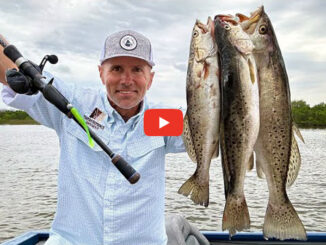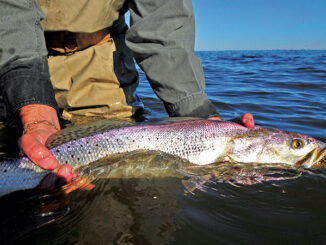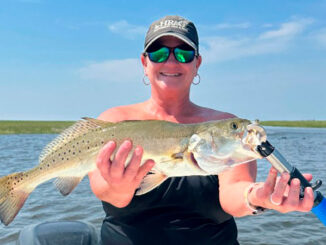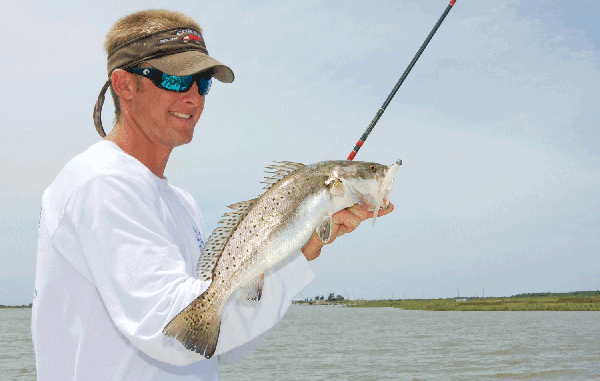
Big Lake gets all the trout-fishing glory in Southwest Louisiana, but look just up the Calcasieu River for a gold mine where fishing is almost too easy.
Capt. Nick Poe just knew back in June he would be having one of the most hellacious fall and winter fishing seasons he had ever experienced on the Calcasieu estuary.
“We got a big rain in June,” the Big Lake Guide Service (337-598-3268) captain recalled. “I mean, it rained here almost every day, and I figured it would flush anything and everything, especially up north around Prien Lake and Lake Charles.”
Poe normally wouldn’t be all that concerned about fishing that far north during the winter because all the water is just so much deeper than Calcasieu Lake.
However, he discovered this past fall that there are a lot of fish up there.
“I guess the big tides we had during the spring pushed a lot of salt water up there, and the fish never really had to leave to spawn,” Poe said. “I think they just stayed there. The way I think about it is, if it’s at all possible that’s where trout want to be because there is so much bait up there.”
Because of that, Poe plans on spending a lot of time fishing within Lake Charles’ city limits this winter.
But why would trout want to be so far north where the Calcasieu River has such a fresh influence on the water? According to Poe, it’s because Prien Lake and Lake Charles serve as what he called a nursery.
“Everything gets started up that way,” he noted. “Fish, bait — you name it. Life begins up there, and as everything grows it moves down the estuary until it hits the Gulf of Mexico.”
Because of its role in raising little ones, Prien Lake and Lake Charles are full of little trout, little pogies and little shrimp. It doesn’t sound very exciting, but anglers can expect to catch a lot of 8-inch trout up here.
But guess what likes to eat little stuff?
Big stuff.
“You may catch one on one cast that’s 8 inches and turn around the very next cast and catch a 5-pound trout,” Poe said. “Even though it’s a nursery, I’m planning on spending a lot of time up there. I caught one almost 27 inches long up there recently, so I’m going up there looking for a good one among all the small ones.”
The main reason a lot of trout can be found within the city limits of Lake Charles this time of year is that they aren’t as dependent on the salinity as they are during the summertime.
They are not trying to spawn any more, and they’re just looking to be able to sit somewhere where they don’t have to fight the tide and eat on a regular basis.
“And there are a lot of places in Prien Lake and Lake Charles where trout can sit on a drop-off and eat all winter long,” Poe explained. “Those spots up there are similar because they have some flats and hard bottoms, but they are way different because it’s really deep up there.”
Poe doesn’t know for sure what the hard bottoms are, but he thought they might be live clam beds because he’s never pulled up an oyster from them.
“I’ve also never dove down there to find out,” he said, “but it really doesn’t matter if it’s clams or oysters because trout hold on whatever it is down there.”
As for the depth difference, Poe has recently been catching fish suspended at 15 feet over 60 feet of water. Because of this deep water, Prien Lake and Lake Charles set up well for wintertime trout fishing.
“Even with all that deep water, I would say that I like to stick around 20 or 25 feet,” Poe noted. “After that it gets pretty boring and monotonous. But when it gets cold, trout go down deeper.
“I don’t know how deep they go because I haven’t figured it out yet. You might be able to go to the middle of the channel and drop a lead-core line down there and catch a 5-pound trout every cast in 50 feet of water.”
Deep water and hard bottoms might be major factors in keeping trout in these two lakes all winter long, but Poe believes it is something much more appealing that forces the fish to stay put.
“Bait,” he declared. “There is more bait up there than there’s ever thought about being in Calcasieu (Lake). I think a large part of that, other than it being a nursery is the depth. There is so much water up there.
“It doesn’t look like it because the lakes aren’t as big, but when you factor in the depth, it’s a lot of water holding a lot of bait.”
Something else worth noting about the water in Prien Lake and Lake Charles is its clarity: Poe said he could see bottom in 4 feet of water in late October, but he expected it to clear up even more during December — assuming the absence of locally heavy rains.
“When it gets cold the algae won’t bloom, and the water gets even clearer,” he explained. “It can get ridiculously clear.
“I’m talking being able to see the bottom in 8 to 10 feet of water.”
Of course, that clarity could vanish overnight if a cold front stalls out over Southwest Louisiana and areas like Kinder north of Lake Charles get a lot of locally heavy rain that runs into the Calcasieu River.
“The effects of a rain like that can be seen as far south as Turner’s Bay,” Poe said. “If it rains over us, we’ll be fine; it’s that rain up north that muddies it up.
“I like to see the Calcasieu River gauge at Kinder. Anything over 10 feet and it’s going to be nasty muddy.”
But as soon as the level drops down to 9 feet, Poe said he wouldn’t be scared to run north. He would much rather see it a lot lower, but with the numbers of fish he’s been catching in the Lake Charles city limits, he will fish less-than-ideal conditions to get on a pile of fish.
Although fishing conditions up north are a lot different than they are in the big lake, Poe said he fishes the same way in Prien and Lake Charles as he does in Calcasieu.
Namely, he looks for the tide to position trout on points and outside bends of the ship channel.
“During the winter, we usually have a pretty good outgoing tide with the north winds blowing after the fronts,” Poe explained. “Anything that tide hits is subject to hold some trout, but that outside bend of the channel that comes up to about 4 ½ feet with water pushing against it — that’s what I’m going to fish.”
The tide doesn’t seem to put the trout right on top of the drop, though, as Poe typically finds them suspended from 15 or 20 feet down all the way to the bottom in about 25 feet of water.
“And the incoming tide doesn’t produce nearly as well,” Poe noted. “I’ve seen it where you just had to have some tide moving, but up this far, the incoming tide isn’t going to have nearly the influence as outgoing.”
Poe expects these trout to be inside the Lake Charles city limits all winter long until they decide to start moving again in February.
“Until then, they’re just looking for a spot to call home where they can eat,” Poe said. “A lot of them are going to make their winter home in Prien Lake and Lake Charles, and they’ll sit right there until the water temperature warms up again.”
Poe might have expected a little hell this fall and winter, but he’s found a little bit of heaven inside the Lake Charles city limits.
